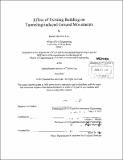Effect of existing building on tunneling-induced ground movements
Author(s)
Law, Rachel Hoi-chee
DownloadFull printable version (12.85Mb)
Other Contributors
Massachusetts Institute of Technology. Dept. of Civil and Environmental Engineering.
Advisor
Andrew J. Whittle.
Terms of use
Metadata
Show full item recordAbstract
The goal of this thesis is to assess the influence of an existing structure on tunneling-induced ground movements. This is accomplished through 2D numerical simulations that are compared with similar prior studies reported by Potts and Addenbrooke (1997). The current study uses the Plaxis finite element code together with the Hardening Soil (HS and HSS) family of constitutive models in order to represent the undrained shear behavior of clay. Input parameters of the HS and HSS models were calibrated for the case of London Clay and compared with results of Potts and Addenbrooke (1997) who used a non-linear elastic model (PJ model). Results have clearly indicated that the choice of soil model has an important influence on the prediction of greenfield ground settlement. The HSS model with the selected set of stiffness parameters provides a reasonable fit with the PJ model and matches closely the greenfield settlement trough expected from empirical models. Numerical analyses are carried out to evaluate the effects of the self-weight, and equivalent elastic bending and axial stiffness of a surface building on tunneling-induced ground movements. For the case of a weightless building, design modification factors for bending and axial stiffness are consistent with results promulgated in Potts and Addenbrooke (1997). For the self-weight scenario, the current analyses indicated that neglecting this factor in the analyses can result in nonconservative estimate of modification factors for deflection ratio and horizontal strain. It is therefore suggested that the effect of building weight cannot be neglected when the boundary effect of building stiffness on the ground is used as a tool to reduce the estimated values of greenfield settlement trough or deflection ratio and horizontal strain of existing buildings in a building damage assessment.
Description
Thesis (M. Eng.)--Massachusetts Institute of Technology, Dept. of Civil and Environmental Engineering, 2012. Cataloged from PDF version of thesis. Includes bibliographical references (p. 113-115).
Date issued
2012Department
Massachusetts Institute of Technology. Department of Civil and Environmental EngineeringPublisher
Massachusetts Institute of Technology
Keywords
Civil and Environmental Engineering.